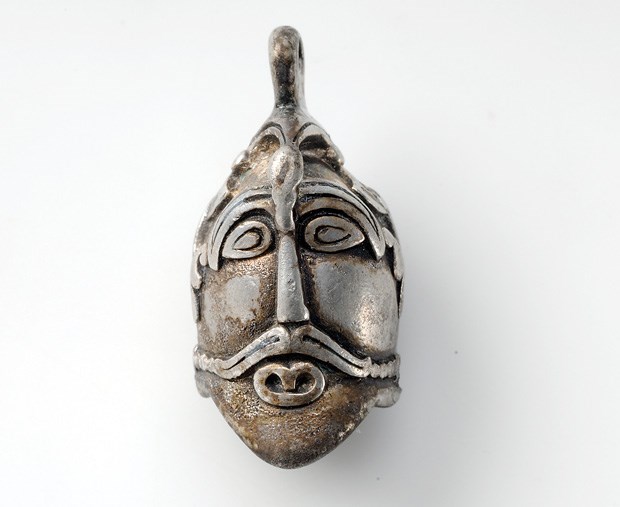"Empires have been built by many means, but the implication here is clear, the Vikings built their roving power on a single collective facility: they understood curves. This knowledge enabled them to build large, fast sea-going ships with shallow enough drafts to navigate far inland on rivers, and light enough to be dragged up on to beaches (Viking raiders got as far into England as Lichfield in the landlocked Midlands, and they raided and colonised far into Russian lands along the tributaries of the Volga)." - Tim Adams, The Observer: "Vikings: Life and Legend - a stirring tale of shock and oar."
Vikings: Lives Beyond the Legends, Royal BC Museum, Victoria, B.C., until Nov. 11. For more information visit royalbcmuseum.bc.ca.
The Royal B.C. Museum's Viking exhibit of rare artifacts from Stockholm's Swedish History Museum brings into focus the day-to day lives of a sophisticated northern culture built from the benefits of massive trade networks and the spoils of war. The Vikings got around.
The Old Norse word "víking" actually describes an activity rather than a person or cultural group. Back in the day the term referred to an expedition away from home which Swedish, Danish, Norwegian and Icelandic groups all took part in as warriors and merchant traders. And when Viking expeditions landed overseas they were called many things, in many different languages. Sometimes they stayed and made themselves right at home (see York in the ninth century), sometimes they kept going.
Northern tribes with Scandinavian connections, such as the Varangians and the Heruls, roamed the river systems north of the Black Sea for centuries before the start of the Viking Age proper began in the 8th century. Both Procopius, a Byzantine scholar writing in Greek, and Jordanes, a Roman bureaucrat writing in Latin, mention the Heruls and their ties with northern Europe. When the tribe killed their king in the Balkans they sent word back to Scandinavia ("Thule") that they needed a new one from the royal bloodlines.
By the time Arab scholar Ibn Fadlan came across a people he called "The Rus" on the Volga River in May of 922 the Viking pattern of cultural expansion was already well established. As an emissary of the Abbasid Caliph of Baghdad, Ibn Fadlan reported back to his boss with tales of men covered from fingernails to neck with elaborate tattoos (of tree patterns and other figures) and armed with axes, swords and knives. Ideologically trees were a big deal: Yggdrasil, an immense ash tree of life, connected the nine worlds of the Norse spiritual cosmos through its roots and branches.
The northern Europeans were of interest to the Abbasid Caliphate as trade partners - the Scandinavians would bring slaves, furs, honey, leather, ivory, fish and other goods south in return for silver coins/dirham. Archaeologists have found buried treasures of Arabic coins throughout Scandinavia but by far the largest concentration is in eastern Sweden and particularly the island of Gotland. The RBCM exhibit includes some of these coins obtained on Viking expeditions as well as a Buddha from India and a Coptic ladle from Egypt.
The Heruls had distinctive cultural characteristics including a warrior seafaring culture, animistic/totemic worship, shamanism, matrilineal socio-cultural status for women (suggested in Freya/Frigg worship) and the use of runes as a writing system.
Between 500 A.D, and the start of the Viking Age proper in 800 A.D., the elder futhark (alphabet) of 24 runes gradually evolved into a leaner 16-character futhark. They were written every which way in the northern pagan culture: left to right, right to left, upside down and in secret code. The use of runes disappeared entirely with the spread of Christianity through the north.
Danish writer Troels Brandt in his research article, The Heruls (gedevasen.dk/heruleng.html), speculates that the Heruls were a strong component in the cultural make-up of Scandinavia, particularly in eastern Sweden (Uppsala and Gotland) from the Age of Migrations onwards. Brandt's theories are based on the research of several scholars focusing on Scandinavian and North Germanic cultures with a particular nod to Andreas Schwarcz, a professor of medieval history at the University of Vienna, whose work follows the Heruls through eastern Europe and central Asia in the last years and on the outskirts of the Roman Empire.
Although the Heruls did not invent runes their distribution closely follows the warrior culture's appearance in classical sources. The Herulian names Hrodolphus, Alaric and Haruth are mentioned along with the Gothic Theodoric and Eric on runestones in Rok and Sparlosa from around 800 A.D. in Gotland.
At the other end of the Viking historical spectrum, Barði Guðmundsson, in his study The Origin of The Icelanders (1967), suggests Herulian cultural components were present in the formation of Iceland. Guðmundsson examines cultural traits in the family lineages of Icelandic settlers using historical research data and material from Icelandic sagas.
The 13th century Icelandic sagas of Snorri Sturluson, the Prose Edda and the Heimskringla, written in poetic form and based on oral literature sources from centuries earlier, contains both mythological information and factual documentation about historical events connecting central Asia and eastern Europe with the northern cultures of the Viking age.
Highly speculative material but worth pondering while exploring the magnificent collection of rare artifacts on display in the RBCM galleries.



